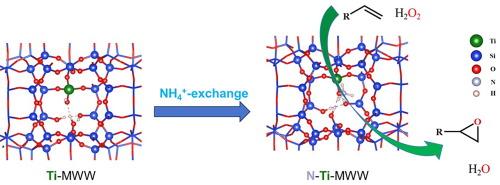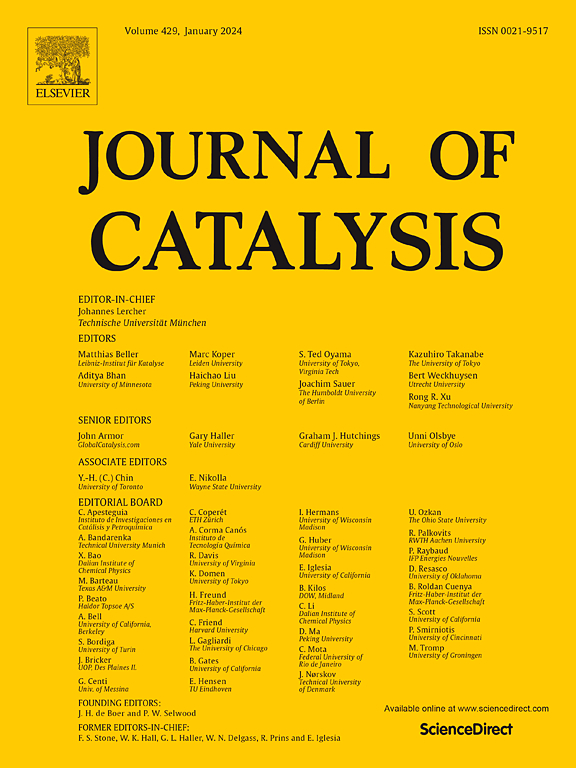Enhanced catalytic performance of NH4+-exchanged Ti-MWW zeotypes for the liquid-phase epoxidation of alkenes with H2O2
IF 6.5
1区 化学
Q2 CHEMISTRY, PHYSICAL
引用次数: 0
Abstract
Ti-MWW zeotypes, characterized by their unique dual pore architecture consisting of intralayer 10-membered ring (MR) pore channels and additional interlayer 10-MR pore channels that are interconnected to intracrystalline 12-MR supercages, exhibit a remarkably catalytic superiority in the selective oxidation of small and/or linear alkenes with hydrogen peroxide (H2O2), surpassing other titanosilicate zeotypes in performance. However, a further improvement on their catalytic performance is still needed for the industrialization of alkene epoxidation over Ti-MWW. In the present work, the introduction of NH4+ species into Ti-MWW was conducted via a facile but effective treatment of the as-synthesized zeotypes with NH4Cl, named N-Ti-MWW. The comprehensive characterization of N-Ti-MWW, derived from NH4+-exchanged Ti-MWW, coupled with Density Functional Theory (DFT) calculations, conclusively demonstrates that the integration of NH4+ into Ti-MWW promotes the generation of -Ti-OOH hydroperoxo intermediates, resulting in a higher catalytic activity in alkene epoxidation in comparison to the parent one. Moreover, the solvolysis of epoxides is significantly suppressed on N-Ti-MWW, enabling the catalyst to display a superior selectivity towards the targeted epoxide, thereby improving its overall catalytic performance. Additionally, N-Ti-MWW is reusable, after the regeneration of the deactivated catalyst simply treated with NH4Cl. As a result, it is anticipated that N-Ti-MWW would be applicable in the industrial epoxidation of alkenes with H2O2.


求助全文
约1分钟内获得全文
求助全文
来源期刊

Journal of Catalysis
工程技术-工程:化工
CiteScore
12.30
自引率
5.50%
发文量
447
审稿时长
31 days
期刊介绍:
The Journal of Catalysis publishes scholarly articles on both heterogeneous and homogeneous catalysis, covering a wide range of chemical transformations. These include various types of catalysis, such as those mediated by photons, plasmons, and electrons. The focus of the studies is to understand the relationship between catalytic function and the underlying chemical properties of surfaces and metal complexes.
The articles in the journal offer innovative concepts and explore the synthesis and kinetics of inorganic solids and homogeneous complexes. Furthermore, they discuss spectroscopic techniques for characterizing catalysts, investigate the interaction of probes and reacting species with catalysts, and employ theoretical methods.
The research presented in the journal should have direct relevance to the field of catalytic processes, addressing either fundamental aspects or applications of catalysis.
 求助内容:
求助内容: 应助结果提醒方式:
应助结果提醒方式:


